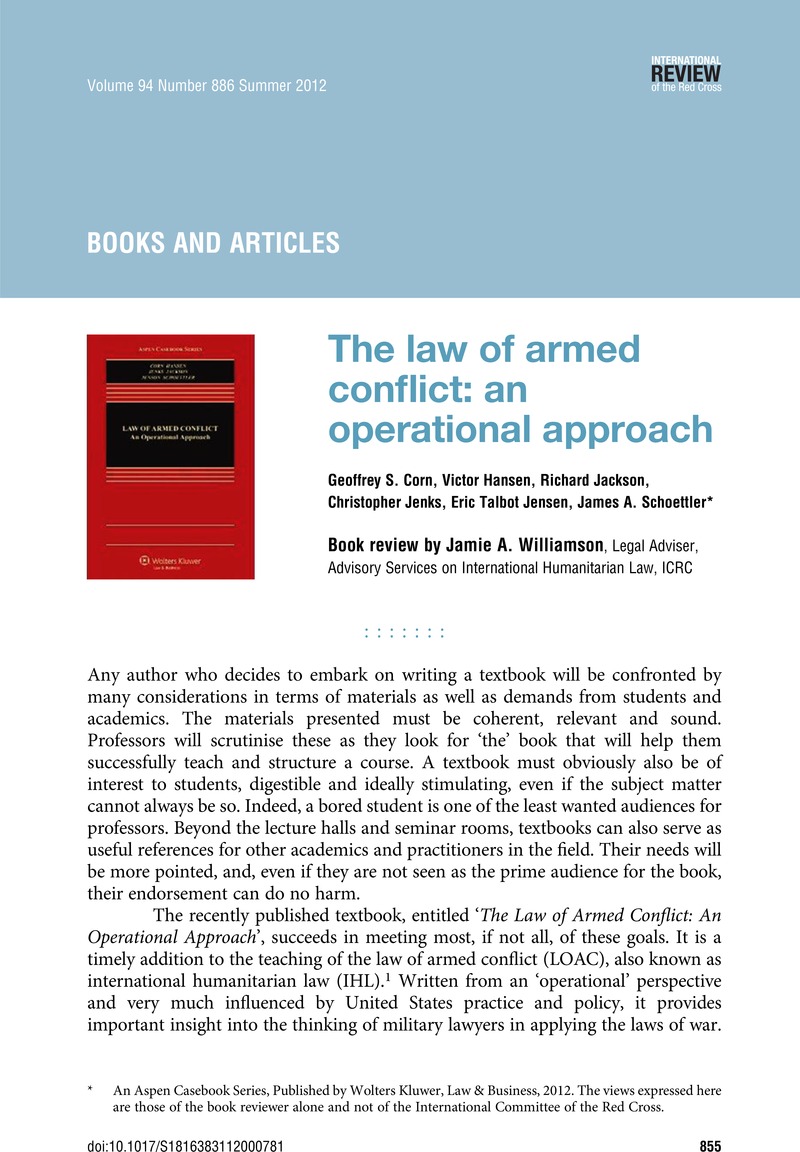Article contents
The law of armed conflict: an operational approach
Published online by Cambridge University Press: 01 May 2013
Abstract

Information
- Type
- Books and Articles
- Information
- International Review of the Red Cross , Volume 94 , Issue 886: New Technologies and Warfare , June 2012 , pp. 855 - 858
- Copyright
- Copyright © International Committee of the Red Cross 2013
References
1 For the purposes of this review, the term laws of war will be used to cover the Law of Armed Conflict ‘LOAC’ (a label generally preferred by military lawyers) and International Humanitarian Law (a label generally preferred by civilian humanitarian lawyers).
2 See for instance Philippe Sands, ‘The Green Light’, in Vanity Fair, available at http://www.vanityfair.com/politics/features/2008/05/guantanamo200805.
3 See for instance ICRC, ‘International Humanitarian Law and the challenges of contemporary armed conflicts’, Report prepared by the ICRC, 31st International Conference of the Red Cross and Red Crescent, December 2011, available at: http://www.icrc.org/eng/assets/files/red-cross-crescent-movement/31st-international-conference/31-int-conference-ihl-challenges-report-11-5-1-2-en.pdf (all last visited October 2011).
4 The ICRC Guidance is available at: http://www.icrc.org/eng/assets/files/other/icrc-002-0990.pdf. See also in New York University Journal of International Law & Politics, Vol. 42, No. 3, Spring 2010: Ryan goodman & Derek Jinks, ‘The ICRC Interpretive Guidance on the Notion of Direct Participation in Hostilities under International Humanitarian Law: An Introduction to the Forum’, pp. 637–640, available at: http://www.law.nyu.edu/ecm_dlv4/groups/public/@nyu_law_website__journals__journal_of_international_law_and_politics/documents/documents/ecm_pro_065929.pdf; Kenneth Watkin, ‘Opportunity Lost: Organized Armed Groups and the ICRC “Direct Participation in Hostilities” Interpretive Guidance’, pp. 641–695, available at: http://www.law.nyu.edu/ecm_dlv4/groups/public/@nyu_law_website__journals__journal_of_international_law_and_politics/documents/documents/ecm_pro_065932.pdf; Michael N. Schmitt, ‘Deconstructing Direct Participation in Hostilities: The Constitutive Elements’, pp. 697–739, available at: http://www.law.nyu.edu/ecm_dlv4/groups/public/@nyu_law_website__journals__journal_of_international_law_and_politics/documents/documents/ecm_pro_065931.pdf; Bill Boothby, ‘“And for Such Time As”: The Time Dimension to Direct Participation in Hostilities’, pp. 741–768, available at: http://www.law.nyu.edu/ecm_dlv4/groups/public/@nyu_law_website__journals__journal_of_international_law_and_politics/documents/documents/ecm_pro_065933.pdf; W. Hays Parks, ‘Part IX of the ICRC “Direct Participation in Hostilities” Study: No Mandate, No Expertise, and Legally Incorrect’, pp. 769–830, available at: http://www.law.nyu.edu/ecm_dlv4/groups/public/@nyu_law_website__journals__journal_of_international_law_and_politics/documents/documents/ecm_pro_065930.pdf; Nils Melzer, ‘Keeping the Balance between Military Necessity and Humanity: A Response to Four Critiques of the ICRC's Interpretive Guidance on the Notion of Direct Participation in Hostilities’, pp. 831–916, available at: http://www.law.nyu.edu/ecm_dlv4/groups/public/@nyu_law_website__journals__journal_of_international_law_and_politics/documents/documents/ecm_pro_065934.pdf.
- 14
- Cited by

